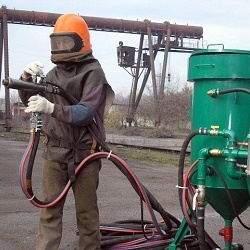Should I use a heat pump to heat the house
The pumping industry is not standing still, and new engineering solutions are emerging based on familiar technologies. Marketers interested in making a profit and increasing sales often conceal data on a particular product, promoting it as revolutionary, unparalleled. The most striking example is heat pumps. Promotional materials do not describe the principle of operation of such devices, nor the level of efficiency for heating a house. However, it is possible to understand how everything works, and how this or that system can be useful, from this material.
Content
- 1 What is a heat pump, its scope
- 2 General principle of work
- 3 The scheme of heating a private house with the use of a heat pump
- 4 Classification of heat pumps by media characteristics
- 5 Division by type of body
- 6 The advantages of heat pumps and the feasibility of their installation
- 7 Main characteristics and calculation of heat pump power
- 8 Conclusion
What is a heat pump, its scope
The technical definition of a heat pump is a device for transferring energy from one area to another with a simultaneous increase in the effectiveness of its work. It is easy to illustrate such a mechanic. Imagine a bucket of cold water and a glass of hot. To heat them, a certain amount of energy has been expended from a certain level of heat. However, the effectiveness of its application is different. If you simultaneously reduce the temperature of a bucket of water by 1 degree, the resulting heat energy can bring the liquid in the glass to almost boiling.

It is for this mechanics that the heat pump works, with which you can make the pool heated or fully provide heating for a country house. The installation transfers heat from one area to another, generally outside the room inside. There are many applications for such a technique.
- At certain rates of heat pump power heating the house becoming inexpensive and effective.
- Easy to make DHW with heat pumpusing boilers secondary heating.
- With some effort and proper design, the creation is completely available. autonomous heating systempowered by solar panels.
- Most models of heat pumps are acceptable. for warm floor, used as a heating circuit.
To select and purchase a suitable system, first of all, it is necessary to correctly set the task before it. And only after they put forward power requirements and assess the acceptability of individual types of heat boilers to meet all needs.
General principle of work
Technologically, the heat pump works according to the familiar to all Carnot cycle, a series of transformations of states of matter. Such words can be completely alien to most users. However, practically each of them has at least one device at home, based on this physical process.
In simple terms, a heat pump is a fridge. Any household model where citizens are used to storing meat and drinks is a heater with an efficiency of more than 100%.Everything works as follows:
- the refrigerator takes away heat from the products placed in it and transfers it to the grille, and therefore to the space of the room;
- at the same time, the air is heated by the compressor.

As a result, spending a certain amount of electricity, the user receives two sources of heat, one of which (the energy taken away from the products) is completely free.
That is the principle of the heat pump. The device has an inverse functional diagram in comparison with a refrigerator - in it the heat exchanger and the radiator grill is useful and is responsible for the final efficiency of the unit. Everything works as follows:
- the heat extraction circuit is located outside the room, surrounded by a stable temperature environment;
- during operation of the heat pump, the temperature of the working fluid is forcibly reduced by natural physical processes below environmental indicators;
- heat is taken off by the working fluid, the intensity of which depends on the temperature difference formed;
- the working fluid enters the state transformation circuit and the heat exchanger of the room;
- energy is released to the air or other medium;
- the working fluid in the initial state is supplied to the beginning of the cycle (heat extraction circuit).
This heating scheme has several advantages and disadvantages. However, under optimal conditions, the heat pump shows significant savings. Heating a house will require 70–80% less cost compared to classic gas and solid-state boilers.
The ultimate efficiency of a heat pump depends on many factors. Some technological solutions are capable of solving only a limited number of tasks. Others suggest complex heat pump installation.
Today, there are a number of household appliances whose owners do not even suspect that they use innovative, revolutionary ideas for selecting the heat of the environment. Moreover, this can occur even at negative air temperatures outside the window. it air conditioning with heating function, which, in fact, is built on the mechanics of the heat pump. The principles of operation of such air-to-air devices will be discussed later.
The scheme of heating a private house with the use of a heat pump
The optimal scheme of using a heat pump for home heating includes storage tank. Simplified, it looks like this:
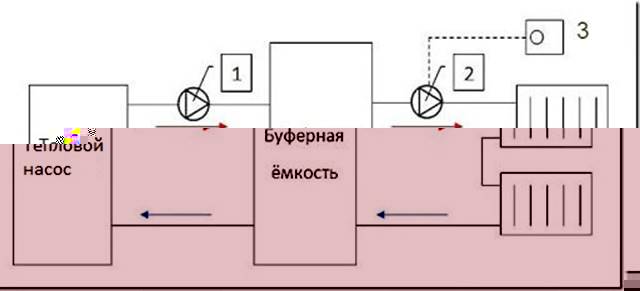
Here, blocks 1 and 2 are valves, which solves the problem of regulating the incoming heat fluxes. They can be manual overlapping of the flow or constitute automated thermal heads. Block 3 is a common thermostat or sensor system.
The heating works according to the following principle:
- the heat pump takes heat from the environment and heats the water;
- the liquid enters either the heat exchanger of the secondary heating of the storage tank, or circulates in a single circuit;
- The heating system is built on the classical principle, the water flow in it is provided by a circular pump.
The scheme shown in the figure - the minimum equipment of the house. It can be easily added. In particular, no one bothers install two tanks and use the principle of secondary heating fluid. One of them - a heat pump boiler (installed directly at the outlet of the latter) - is used for hot water supply. A more volumetric tank solves the problem of supplying coolant to the heating system.
Excellent option works home heating with heat pump, accumulative capacity and system a heat-insulated floor.In this case, it is not necessary to heat the liquid to a high temperature. The optimal rate for underfloor heating - from 30 to 40 degrees. The heating scheme is similar to the one already mentioned, but instead of radiators, water flows to the collector unit with its own flow control.
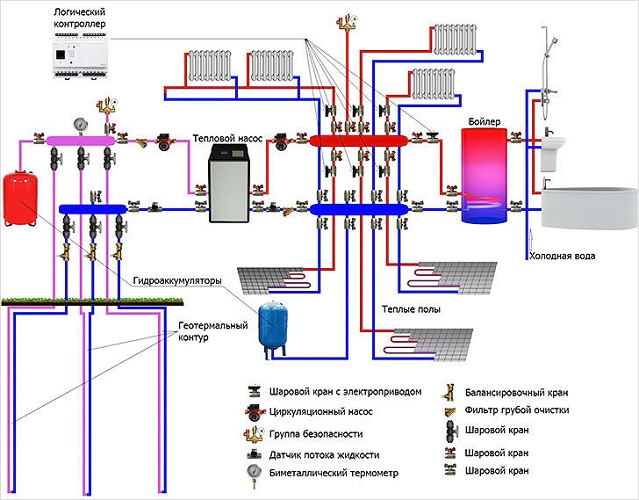
Classification of heat pumps by media characteristics
The classification of heat pumps is quite voluminous. Devices are divided according to the type of working fluid, the principle of changing its physical state, the use of conversion devices, the nature of the energy carrier required for operation. If we consider that models with various combinations of classification criteria are presented on the market, it becomes clear that it is rather difficult to list everything. However, you can consider the basic principles of group division.
The installation, design, and final characteristics of the heat pump depend on the parameters of the heat source and the recipient environment. Today there are several types of engineering solutions.
Air-to-air
Air-to-air heat pumps - most common devices. They are compact and fairly simple.On the mechanics of this type of domestic air conditioners operate with heating mode. The principle of operation is simple:
- the street heat exchanger is cooled below the air temperature and takes heat;
- after compression of the incoming freon into the radiator, its temperature greatly increases;
- the fan inside the room, blowing the heat exchanger, heats the room.
The selection of environmental energy is not necessarily made by an external heat exchanger. For this purpose, air can be forced into a block located in the room. This is how some work channel systems.
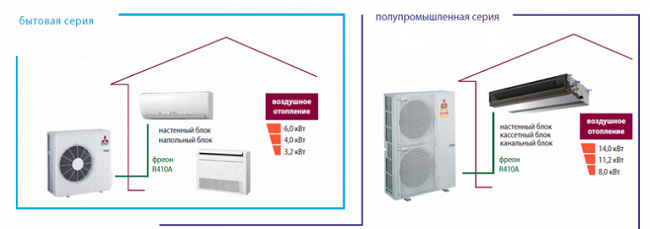
If freon is compressed and expanded in an air conditioner, then in vortex heat pumps simple air is used. The mechanics of work are similar: before the gas enters the internal heat exchanger, the gas is compressed, and after giving up energy, it is blown by an intense stream into the heat extraction chamber.
A vortex heat pump is a large, massive installation that works efficiently only when the ambient temperature is high. Therefore, such systems are installed in industrial workshops, they use the exhaust gases of furnaces or the hot air of the main air conditioning system as a source of heat.
Water-water
A water-to-water heat pump works on the same principle as other installations. Only energy transfer media are different. The equipment is equipped immersion probes, so that even in the conditions of tough winter, to reach the groundwater horizon with a positive temperature.
Depending on the needs of heating, water-to-water heat pump systems can be completely different sizes. For example, starting from several wells drilled around a private house, ending with large area heat exchangers located directly in the aquifer that are laid during the building construction phase.
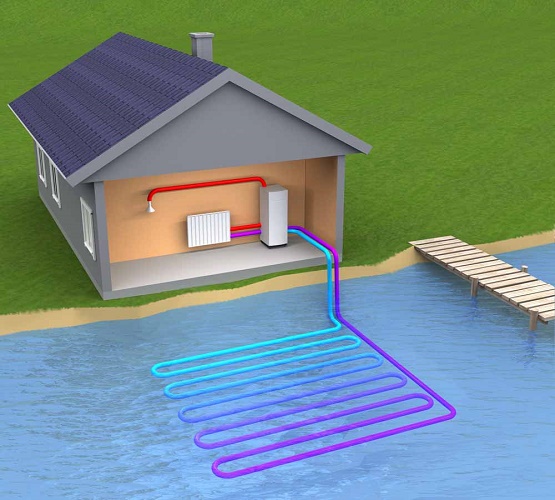
Water-to-water heat pumps are distinguished by greater productivity and effective output power.. The reason is the increased heat capacity of the liquid. The layer of water in which the probe or heat exchanger is located quickly releases energy, and due to the huge volume it slightly reduces its characteristics, contributing to the stable operation of the system. Also water-to-water equipment is different. increased efficiency.
Water-air, air-water
Combined systems must be chosen carefully. At the same time, existing climatic conditions are carefully evaluated. For example, a water-to-air heat pump cycle has good efficiency for heating. in regions with severe frosts. The air-to-water system in conjunction with a warm floor and a cumulative secondary-heating boiler is able to show maximum savings in the territories, where the air temperature rarely falls below -5 ... -10 degrees.
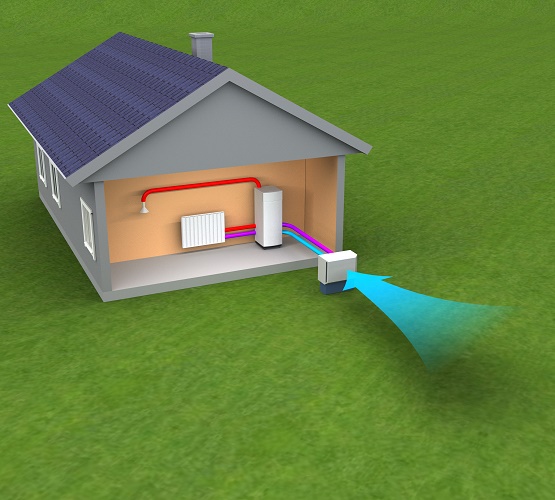
Melt (brine) -water
The heat pump of this class is a kind of wagon. He can applied literally everywhere. Indicators of its net heat output are constant and stable. The principle of operation of the brine-water device is based on the selection of heat, primarily from the soil, which has normal indicators of moisture or marshy.
The system is easy to install: to accommodate external heat exchangers, it is enough to bury them to a certain depth.You can also choose one of the options of equipment with a gaseous or liquid working fluid.
The calculation of the heat pump class brine-water is done in terms of energy demand for heating. Methods for its quantitative determination abound. You can make the most accurate calculation, taking into account the material of the walls of the house, the design of windows, the nature of the soil, the weighted average air temperature and much more.
Manufacturers of brine-water systems offer various versions of models differing in the power consumption of the conversion unit, the design and dimensions of external heat exchangers, and the parameters of the output circuit. Select the optimal heat pump on a pre-formed list of requirements is easy.
Division by type of body
Modern heat pumps can use a gaseous body or a chemical liquid ammonia solution as a heat transporter. The suitability of a particular scheme is evaluated on several factors, the characteristics of the systems.
- Installations using freon, have a heat pump cycle based on gas compression and expansion processes. They are somehow built on a compressor circuit.The equipment has attractive performance indicators, but it also has drawbacks. Although the weighted average consumption of the system at the time of the operating cycle is stable, the wiring is heavily loaded. In addition, heat pumps with a gaseous heat conveyor will not be useful in regions where there are no centralized electricity networks or a power source with sufficient load capacity.

- Installations of evaporative type using ammonia solution, have a duty cycle based on the process of evaporation of a substance at low boiling points. The liquefaction after the passage of an external heat exchanger occurs under the action of an energy source. This is a heat burner. Almost any fuel can be used for it: solid, gasoline, diesel, gas, kerosene, in some cases - methyl alcohol. Therefore, evaporative heat pumps are attractive in places where there is no electricity. In addition, the choice of such equipment can push the cheap fuel of a certain type in the region.
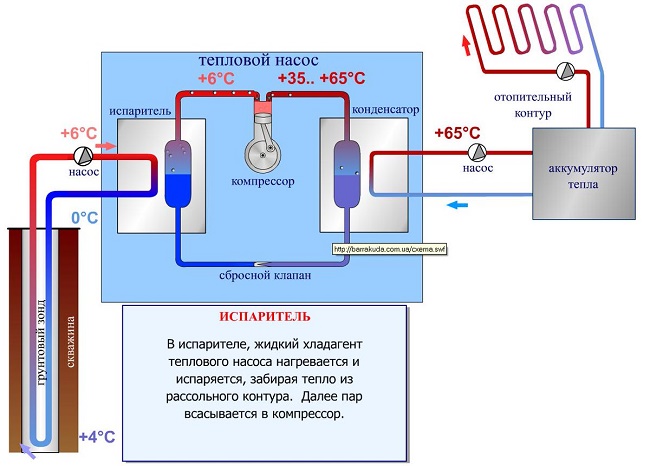
The nature of the working medium used in the system can tell a lot about the plant performance and power output.So, freon compressor heat pumps are capable of a sharp jerk, quickly warming up the room. Ammonia evaporative models for such feats are not capable. Their preferred mode of use is stable, constant operation with nominal heat transfer.
The advantages of heat pumps and the feasibility of their installation
As stated in advertising, the main advantage of heat pumps is heating efficiency. To some extent, it works that way. If the heat pump has an energy take-off environment that provides optimal temperature readings, the installation works efficiently, heating costs are reduced by about 70-80%. However, there are always cases where the heat pump can be an irrational investment.
The efficiency of the heat pump is determined by the following technological characteristics:
- the parameter of the limiting limit of temperature decrease by the working fluid;
- minimum difference in temperatures of the external exchanger and the environment, at which the heat extraction is extremely small;
- the level of energy consumption and recoil of useful thermal power.
The feasibility of using a heat pump depends on several factors.
- Territories where such equipment does not show good results - regions with frosty winters and low average daily temperatures. In this case, the heat pump is simply not capable of extracting enough heat from the environment, closely approaching the zone of zero efficiency. First of all, it concerns air-to-air systems.
- With an increase in the volume of heated space, the technological parameters of the heat pump increase almost exponentially. Heat exchangers become larger, the size and number of immersion probes in water or ground increase. At a certain point, the cost of the heat pump for heating required expenses for its installation and maintenance, as well as the payment of power consumption are simply irrational investments. It is much cheaper to create a classic gas heating scheme with a boiler.
- The more complex the system, the more expensive and it is more problematic to repair in case of breakage. This is a negative addition to the size of the heated area and the characteristics of the climate zone.
Classic is heat pump and gas / solid fuel boilerworking in a bundle. The idea is simple: the products of combustion of fuel are displayed on a wide pipe. It is located heat exchanger. In the system of heating and hot water supply storage tanks and an indirect heating boiler are installed. The equipment (boiler and pump) is activated simultaneously when the temperature of the fluid in the distribution network drops. Working in pairs, they almost completely utilize the energy of burning fuel, showing near-maximum efficiency indicators.
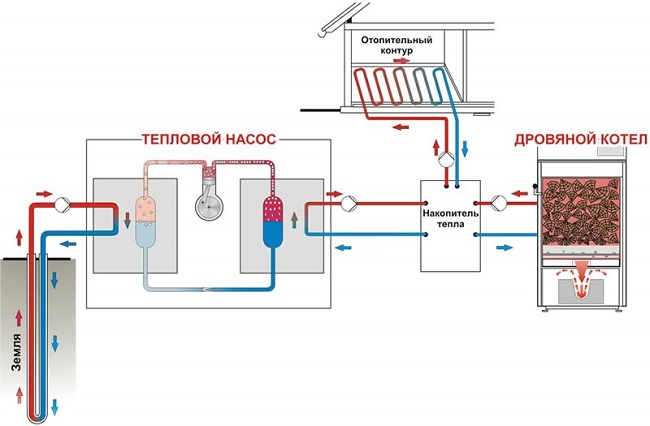
The system with adaptation to environmental characteristics is built on heat pump, fan unit, heat gun of any class. With a sufficiently high air temperature on the street (up to -5 ... -10 degrees Celsius), the heat pump operates in normal mode, providing sufficient power output for heating. The design feature of the system is the location of its external heat exchanger in a separate ventilation duct.When the temperature on the street below the optimal mark, the supplied air is heated by a heat gun (diesel, electric or gas).
It is worth noting: most of the schemes providing for adaptation to air temperature or stabilizing parameters of the heat pump operation are applied to air-to-air and air-to-water devices. Other systems, due to external heat exchangers isolated in the ground or in water, do not allow the creation of such “greenhouse” working conditions.
Main characteristics and calculation of heat pump power
The general rationality of the installation of a heat pump for heating a house is estimated, above all, on financial expenses. These include:
- equipment purchase price;
- installation costs, which may include land works;
- expenses for periodic maintenance;
- approximate cost of eliminating frequent problems.
Choice of power model, as mentioned above, is based on the overall need for heat supply. An approximate calculation for a one-story house of 10x10 meters (300 cubic meters of volume) looks like this:
- takes into account the maximum negative winter temperature (-20);
- the difference between the room and the environment is determined (20 - -20 = 40);
- the heat losses of the walls are calculated, according to the reference data of their material (for a brick, the table value is 1, heat loss is 1x300x40 - 12000 kilocalories per hour or 13.5 kW).
The resulting figure is an indicator of the minimum power of the heat pump, which is enough to heat the house. To select the optimal model, the characteristic must be increased by at least 50%. This is done due to the fact that the heat pump in winter will have to work in non-optimal conditions, close to the lowest point of zero efficiency in ambient temperature. The resulting figure for the considered example is about 20 kW.
The second part of the calculation is choice of storage tank capacity. It is recommended to install this part of the system so that the heat pump can work for a limited number of cycles per day. The documentation for the equipment provides recommendations on the volume of the heat accumulator for a specific indicator of cyclicality. The average figure is 30 liters per kilowatt with 3 launches, 20 liters with 5 launches. Thus, for the house in this example, you need a storage tank of at least 400 liters for five cycles of heat pump operation per day.
Conclusion
If, as a result of the analysis of the climate, available energy sources, the nature of the soil, it was decided to buy a heat pump for heating, it is recommended entrust system design to professionals. The optimal choice of model is based not only on the features of the equipment and the mechanics of its work. Specialists will take into account the heat transfer of the soil, choose a combined scheme with good efficiency, calculate the best option for carrying out the land works. Therefore, the heating system with a heat pump, developed by professionals, will not make you encounter surprises and regret your choice.

/rating_off.png)








